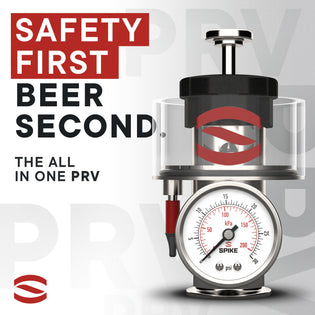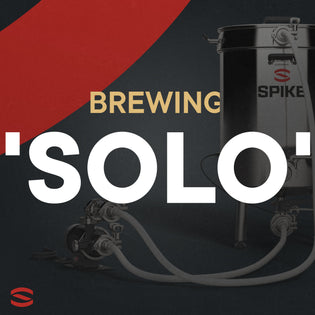
With new equipment hitting the home brewing market every day, there hasn't been a better time to be a home brewer. Technology is finally catching up to what's available professionally for brewers and the techniques they use can be replicated at home better than ever before. Among these advances is the availability of stainless-steel conical fermenters on the 5-30 gallon scale. These vessels, among other things, allow the home brewer to maintain pressure on their beer. This makes common practices like force carbonation, closed pressure transfers, packaging and serving directly from storage possible. But what about fermentation itself? How can the ability to pressurize a fermenter play into the behavior of primary fermentation? Some information is presented below.
Key Takeaways
- Pressurizing a fermenter can affect the behavior of primary fermentation.
- Pressure can reduce fusel alcohols and esters, but can also inhibit yeast growth which can lead to a higher final gravity and stalled fermentation.
- When experimenting with pressurized fermentation, ensure the vessel is properly relieved of excess pressure and that other variables like temperature, OG, pitching rate and aeration are isolated.
Ready to take your fermentation to the next level? Spike's line of pressure-capable fermenters can help you reduce esters and fusel alcohols, resulting in a cleaner, more refined brew. Upgrade your setup today and see the difference for yourself.
Primary Fermentation and Pressure:
Professionally, the blow off method is predominantly used to allow carbon dioxide to escape during primary fermentation. However, with the market shift to IPA's that are dry hopped earlier and earlier in the process, the question is, how much delicate hop aroma is lost from blow off? How does large tank geometry, with large hydrostatic pressure, affect beers produced commercially, versus those produced on smaller home brewed scales? Not much research exists on the manner so home brewers have been experimenting with pressurized primary fermentation to see if it positively affects their beer. Experimentation is at the core of what home brewing is all about, so have fun, but this approach is not without its risks to the fermentation process and your safety, so here are some things you should know.
By and large, yeast do not like pressure as it inhibits their activity and in extreme conditions, can kill them. In primary, an increase in pressure subdues just about every characteristic the brewer thinks about during fermentation. The table below summarizes how pressure affects some of these activities.

While the reduction in fusel alcohols and esters may be a welcomed positive, the suppression in growth can cause issues with attenuation and stationary phase clean up. For example, a healthy culture of yeast will usually clean up these byproducts themselves after you reach terminal gravity, but if growth is inhibited by pressure, this can stall the process. Moreover, if yeast growth isn’t strong enough, the beer can also end at a higher final gravity, producing an undesired sweetness.
By and large, yeast do not like pressure as it inhibits their activity and in extreme conditions, can kill them.
In the case of New England IPA's, it's also important to point out that the interaction of active yeast with hop oils is part of what produces the juicy flavors now prized by the consumer (known as bio-transformation). Certain esters may also be desired in this style. Therefore, pressurized fermentation may affect this interaction given its effect on yeast activity.
When adjusting pressure
It’s also important to remember that many other variables effect fermentation as well. Factors like temperature, OG, pitching rate and aeration can all create undesired or desired effects, so be sure to isolate pressure as the only experimental variable when conducting pressurized experiments.
Finally, you must ensure your vessel is properly relieved of excess pressure. With the amount of carbon dioxide yeast produce during fermentation, a fully sealed vessel can create a potential explosion hazard. As a brewer, be sure to take the proper precautions with pressure release valves or spunding valves set below the limits of your vessel. It should be noted that aroma will escape at low spunding levels as well, which defeats one of the drivers of fermenting under pressure in the first place.
FAQs
What is the blow-off method?
The blow-off method is a technique used by professionals to release gas like carbon dioxide to escape during primary fermentation. But for homebrewers, an easy and quick way to keep oxygen out during fermentation is to add a blow-off cane. The blow-off cane can go directly into a bucket of sanitizer during primary fermentation.
What is the Spike All-In-One PRV?
The All-In-One PRV ( Pressure Relief Valve) puts your safety first. This pressure relief valve has an adjustable pressure release knob, pressure gauge, gas post, quick release plunger and sanitizer cup with drain. It puts your safety first without compromising on features or functionality. And when you're dealing with pressure, that's pretty darn important.
What is spunding?
Spunding can be used to regulate the carbonation level of the beer during the fermentation. This is achieved by regulating the temperature and pressure in the fermenter using a pressure-relief valve or a pressure gauge, which allows the brewer to precisely control the carbonation level of the beer as it ferments.
Spunding is often used by brewers who want specific styles of beer, such as Belgian ales or German lagers.
What are the risks of pressure fermenting?
The risks of pressure fermenting include but are not limited to inhibiting yeast activity and killing yeast in extreme conditions, over-carbonation of the beer, flavor and aroma changes, contamination of the beer by bacteria, as well as creating a potential explosion hazard if the vessel is not properly relieved of excess pressure.
To prevent these risks, a pressure relief valve (like the All-In-One PRV) is a good tool to add to your homebrewing setup so you can put your safety first without compromising on features or functionality.
What other variables can affect fermentation?
Other variables that can impact fermentation include temperature, oxygen, pH, water, nutrients, and time. Too low a temperature can slow down the fermentation process. Too much oxygen can affect the flavor and aroma of the beer. If the pH is too low or too high, it can affect the yeast activity, and as a result, affect the beer quality.
Check out the blogs below for more information about yeast, fermentation, water chemistry and all the other variables that could affect the outcome of your delicious brew!
- Water Chemistry and pH Balance
- Yeast Harvesting
- Yeast Starter Kits
- Comprehensive Guide to Fermentation
In summary
Brewing science in this arena is not well documented. To encourage a healthy and complete fermentation, the traditional blow off method remains the gold standard among professionals. If you are going to try pressure fermenting and/or spunding be sure to do it safely. The easiest to use and most safe device on the market is the All-In-One PRV.
John Degroote - Head Brewer
New Barons Brewing Coop
Milwaukee, WI









